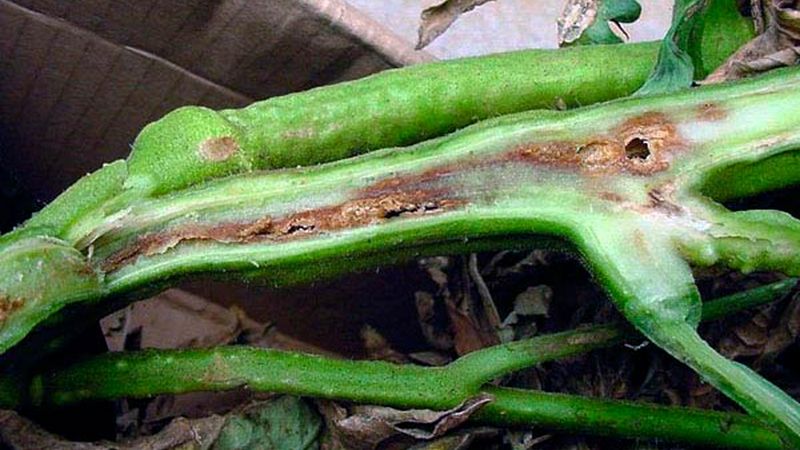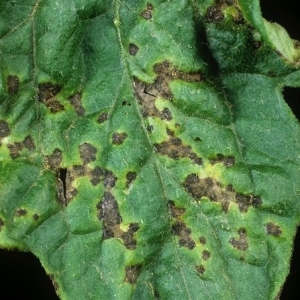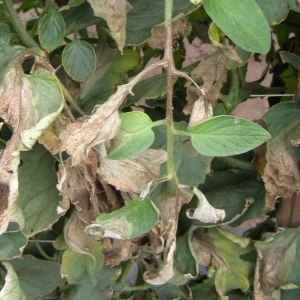What is tomato bacteriosis, why does it appear in the greenhouse, and how to quickly and effectively cure it
Novice gardeners may naively believe that a greenhouse will save tomatoes from diseases. However, in fact, it turns out that artificially maintained temperature and humidity indicators are favorable for pathogens of many diseases. What if the plants began to wilt for no apparent reason? It can be tomato bacteriosis. What kind of disease, can it be cured and how to protect the crop from death - you will learn all this from our article.
The content of the article
Tomato bacteriosis - what is this disease
Bacteriosis is a dangerous disease that develops imperceptibly, but because of it, the entire crop may die.... The disease belongs to the bacterial type, it can affect the roots and the vascular system of the plant. The causative agent is multinucleated bacteria from the family Mycobacteriaceae, Pseudomonadaceae, Bacteriaceae.
Bacteriosis includes wet rot, root cancer, black leaf spot and general plant wilting. The onset and development of the disease depends on the number of bacteria that enter the plant, the stability of the culture and the environmental conditions.
How does it affect tomatoes
The infection works from the inside: mucus begins to form in the stem. This is due to bacteria blocking the vascular system of the plant. Tomatoes wither. And not just tomatoes. Such types of bacteriosis as wet rot and black spot affect indoor plants, but more and more often cucumbers, grapes, beans, wheat and other crops began to suffer from them.
Symptoms and external signs
The disease develops very slowly, which is why gardeners recognize it at the last stages, when it is impossible to correct the situation. The latent form can last up to two months: there are no symptoms, however, vascular blockage and decay have already begun inside the stem. As soon as hot and humid weather sets in, the course of the disease becomes rapid, the plant dies in a few days.
Bacterial wilting
 The disease can occur in two forms: acute and chronic. The first form occurs instantly - the plant dies in three days.
The disease can occur in two forms: acute and chronic. The first form occurs instantly - the plant dies in three days.
The second form lasts no more than a week, while not only the stem is affected, but also the fruits of the plant. In the photo of diseased plants, yellowed and twisted leaves are visible.
Bacteriosis symptoms:
- the appearance of brown stripes on the stems;
- formation of "air roots" on the root part;
- yellowness of the leaves at the bottom of the stem;
- a delay in plant development - fruiting shoots stop growing;
- mucus is released when the stem is cut.
Black spot
The disease develops in hot weather; when the temperature drops, the pathogen does not die. At the initial stage, shapeless brown dots and spots appear on the leaves, then the formations begin to increase and turn black - tissue necrosis occurs.
The death of a plant begins with the fall of the leaves, then it turns black and curls. Fruits also suffer from the disease: dots may appear on tomatoes, which later develop into ulcers.
Reasons for the appearance and distribution
Bacterial wilting is caused by the bacteria Erwinia phytophthora, which lives in the upper layers of the soil. The microorganism infects not only nightshade, but also other vegetable crops. The bacteriosis spreads through the root system of the plant.
Damp hot weather with sharp temperature changes during the day and night is a favorable factor for the vital activity of bacteria.
Terms of distribution
Bacteriosis develops rapidly if the air temperature in a greenhouse or a greenhouse is + 19 ... + 24C and there is drop-liquid moisture. In addition, the spread of the pathogen is facilitated by a high level of soil pH, a lack of phosphorus and potassium, and the presence of moisture on plant leaves. Excessive use of nitrogen fertilizers also reduces the resistance of tomatoes to the causative agent of the disease.
Bacteriosis transmission methods:
- damage to the plant stem during weeding, transplanting or loosening;
- with insects and rodents that carry bacteria from sick to healthy tomatoes;
- watering with water containing the pathogen;
- work with raw garden tools.
Fighting the disease
Means of struggle can be divided into chemical, agrotechnical and folk remedies.
Chemicals
It is impossible to cure tomato bacteriosis, but if you do not take any measures, wilting can spread to healthy seedlings. The affected plant is uprooted and burned.
The rest of the seedlings are treated with "Fitolavin" - 20 ml of the substance is dissolved in 10 liters of water. The solution is divided into two parts: one is used for spraying on the leaves of plants, the second for watering under the root - 30 ml of solution is used for one bush.
After the infected plants are burned, it is necessary to decontaminate the soil. For these purposes, you can use the drug "Baikal-EM" - dissolve 125 ml of the substance in a bucket of water. For 1 square meter, 2.5 liters of solution will be required.
Important! Do not treat the soil with chemicals while any plants are growing on it.
For spraying, processing leaves and watering, you can also use the preparations "Phytoplasmin", "Azofos 65%", "Virkon S", "Farmayod".
Traditional methods
If it is not possible to purchase special preparations for treating plants and soil, you can use a 1% manganese solution - 10 g of potassium permanganate is dissolved in 1 liter of water. The solution is poured over the soil on which the infected plants grew.
You can slow down the spread of the disease with the help of "Streptomycin" - dilute 2 bottles of the drug in 10 liters of water, add 15 g of quicklime blue stone. Treat diseased and healthy plants, repeat the procedure after 3 days.
Agrotechnical techniques
You can avoid the development of tomato diseases if you observe crop rotation on the site. Tomatoes cannot be planted in the same place from year to year, you need to take a break between planting in 3-4 years.
Read also:
Why does gray rot appear on cucumbers and how to deal with it.
How to deal with tomato top rot in a greenhouse.
What to do if tomatoes turn black at the bottom and how to prevent the problem.
Prevention
It is easier to prevent bacteriosis than to try to cure it.
Prevention of bacteriosis consists in observing the following rules:
- disinfect soil and seeds before planting;

- when buying, pay attention to the resistance of the variety to bacterial wilting;
- keep the beds clean so as not to attract rodents and insects that carry bacteria;
- regularly disinfect garden tools;
- observe the crop rotation of the site;
- after harvesting, remove the topsoil and treat the area with fungicides.
Gardener tips
Experienced gardeners know that you can protect tomatoes from many diseases if you disinfect the seed before planting. To do this, you can use the drug "Fitolavin" - dissolve 2 ml of the substance in 100 ml of water, soak the seeds in the solution for one hour.
It is also important to disinfect garden tools with the preparation "Ecocid-S" - 50 g of the substance is dissolved in 5 liters of warm water. Spray rakes, diggers.
At the first signs of illness, you can try to pinch the growth point.This method will not cure the plant, but it can delay its death.
If the bacteriosis began to affect the tomatoes, then it is necessary to pull out not only diseased plants, but also 10 healthy bushes that are in the same row with them.
Conclusion
Tomato bacteriosis is a dangerous disease that can lead to the loss of the entire crop. Diseases of the bacterial type can be avoided if the seed and soil are processed before planting, do not forget about regular disinfection of gardening equipment and observe crop rotation.
If these preventive measures did not help, you can try to save the crop by spraying and watering under the roots with special preparations. In most cases, it is useless to treat the disease; it is much more effective to prevent its development.